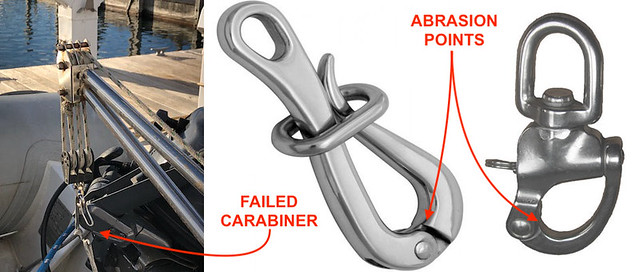Load Testing
I have professional experience managing and directing various crane systems, and we had to have records of the weight tests, conducted by professionals with certified weights, with stamped metal tags on the cranes signifying current certification. These tests were specified to occur at various intervals of years, depending on the assigned task for the crane. The weights used reflected the percent safety factor involved, some systems having a 5 to 1 while others might be 2 to 1, meaning the system could lift and support 5X, 4X, 3X, or 2X their rated capacity for x minutes. This was not a breaking strength capacity test of anything.
In our boating, there seems to be no such service. We accept that a certain cable or sling has XXX "capacity," but what does that number really mean? Is it breaking strength, working strength, and if working strength what was the BS so you can work out the safety factor for yourself.
I would not want to lift a dinghy without a 3 to 1 safety factor on the rig based on the working strength (including every single bit of the rig), not breaking strength, of the rig. That should account for a fair amount of shock loading and aging for at least a few years
But you still need a weight test if you want to be sure. One member mentions hoping into the dink while suspended to test it out. Maybe not the safest idea, but a start. My suggestion is that if the calculated weight of dink and motor and gear is 200 pounds, put it in the water or on the pier, and pour another 400 pounds of stuff (preferably NOT people) or liquid into it before lifting it an inch ir two clear for five minutes, or barrow a scale and attach it to a line around your hull or to a pier and generate the 600 pound lift that way.
Now you are certain the hoist is good; otherwise, you are hoping.
I witnessed accidents in lifting, and because the cranes were certified, they were not the cause. Rather weaknesses in things like an eye pad on a large engine caused the problem. And because of stringent safety rules AND vigilant safety officers, nobody was injured.
Witnessing a twined set of Detroit 871s and attached transmission literally bouncing around after hitting bottom will make a believer out of you every time. Same thing in regard to half inch thick wire cable snapping across decks looking for legs to slice off. You are your own safety officer, and the fact that we do not seem to hear about people being hurt by failed rigging and falling dinks probably means y'all are doin' good.


